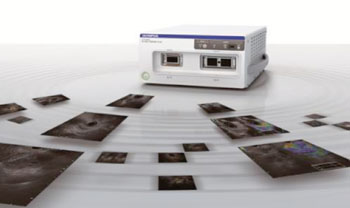Ultrasound Processor Supports Optimized Characterization of Lesions in the Gastrointestinal Tract and Airways
By MedImaging International staff writers
Posted on 13 May 2014
A next-generation ultrasound processor can incorporate both endoscopic and endobronchial ultrasound (EUS/EBUS) on one workstation. The system provides excellent performance and is cost-effective through cross-departmental functionality for the gastrointestinal (GI) and pulmonary markets.Posted on 13 May 2014
Olympus Medical Systems (Center Valley, PA, USA), a technology company that design diagnostic and therapeutic solutions in medical and surgical procedures, among other core businesses, has launched the EU-ME2, which provides excellent clarity to EUS and EBUS procedures, supporting better detection and characterization of lesions in the gastrointestinal tract and airways.

Image: EU-ME2 brings superb clarity to EUS and EBUS procedures, supporting better detection and characterization of lesions in the gastrointestinal tract and airways (Photo courtesy of Olympus Medical Systems).
Olympus is a developer of endoscopic ultrasound (EUS), which combines ultrasound technology with endoscopy to better visualize the digestive tract tissues and adjacent anatomic structures inside the human body. With EUS, the transducer is endoscopically inserted into the body through the digestive tract, putting it closer to the area of interest to capture higher resolution images.
The system provides excellent image quality for EUS applications, comparable to a large radiology processor, in a compact model. It is designed to meet the requirements of gastroenterologists performing a wide range of EUS procedures. New and enhanced features optimize visualization and assist in diagnostic, therapeutic and interventional procedures for cancers and diseases of the GI track and surrounding organs, such as the pancreas, bile duct, liver, spleen and gallbladder.
“EU-ME2 is a major development in the field of pancreatic-biliary endoscopy, as EUS is increasingly being used for accessing the bile duct following a failed cannulation at ERCP,” said Dr. Shyam Varadarajulu, medical director of the Center for Interventional Endoscopy (CIE) and professor of medicine at the University of Central Florida (Orlando, USA). “The technology is advanced, compact, versatile and packed with ‘high-end’ features; it seamlessly integrates diagnostic and therapeutic capabilities that will elevate care to the next higher level for years to come.”
The system also offers full support for endobronchial ultrasound procedures. EBUS allows visualization of the airways and adjacent structures. Along with its predecessor, Olympus’ EU-ME2 is the only platform that offers both linear and radial EBUS capabilities in one ultrasound processor for enhanced procedural and cost efficiencies.
The versatile EU-ME2 is compatible with a wide range of Olympus EUS and EBUS scopes as well as ultrasound miniature probes. Since the processor is suitable for gastroenterology, pulmonary and thoracic surgery application, it offers healthcare facilities with a cost-effective resource that can be shared across specialties.
“As healthcare facilities look for ways to improve patient satisfaction while reducing care delivery costs, we are pleased to be able to offer our customers a versatile, state-of-the-art ultrasound platform for GI and pulmonary applications,” said Luke Calcraft, president of the medical systems group at Olympus Corporation of the Americas. “The EU-ME2 enables physicians to realize clinical efficacy through premier imaging. It also helps healthcare facilities achieve efficient asset management to realize significant cost savings through lower cost of ownership.”
This next-generation processor further expands the boundaries of endosonography with advanced features such as: (1) improved B-mode for more accurate identification of tumors and tissue properties and boundaries; (2) high resolution flow (H-Flow) mode to image small vessels around the tip of the endoscope for more precise anatomic identification; (3) pulse wave Doppler (PWD) mode to measure blood flow velocity in a specific location to help identify the target area of interest; (4) elastography (ELST) mode to map tissue elasticity, which may help indicate disease and highlight areas to biopsy; (4) lastly, tissue harmonic echo (THE) mode for improved resolution, improved signal-to-noise ratio, and reduced imaging artifacts (only available in the Premier Plus version of the EU-ME2).
Olympus Medical Systems Group, a division of global technology leader Olympus (Shinjuku, Tokyo), develops solutions for healthcare professionals that help improve clinical outcomes, reduce overall costs and enhance quality of life for their patients.
Related Links:
Olympus Medical Systems














